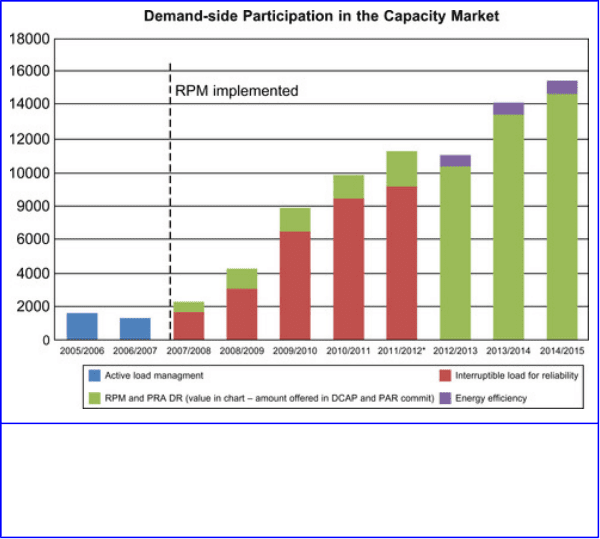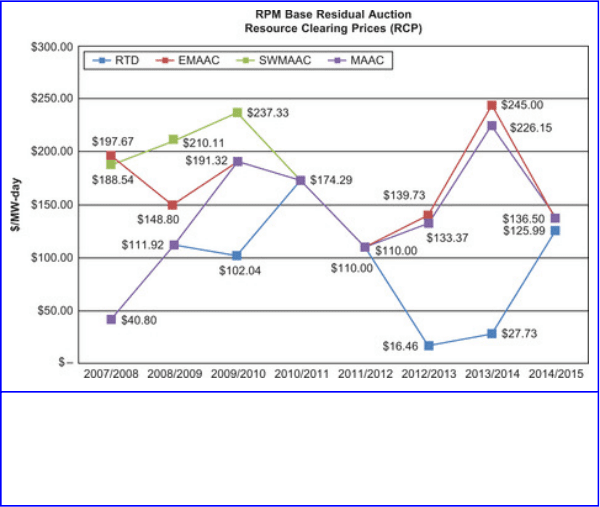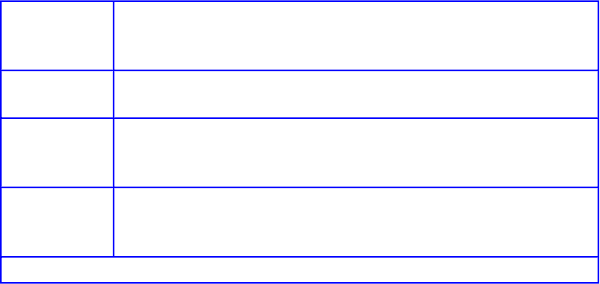Sioshansi F.P. Smart Grid: Integrating Renewable, Distributed & Efficient Energy
Подождите немного. Документ загружается.


As Table 17.1 shows, and will be contrasted below, the price
of capacity in the previous construct provided little incentive
for DR to participate as a capacity resource as the market was
signaling that there was little value as a capacity resource.
RPM Capacity Market
The RPM Capacity Market introduced a paradigm shift in
how LSEs could satisfy their capacity obligations and how
DR could participate as a capacity resource. RPM created a
three-year-forward auction for capacity (known as the Base
Residual Auction or BRA) where LSEs had to cover their
capacity obligations. This is a paradigm shift from the
previous Capacity Credit Market that allowed assignment of
resources up to the day before they were needed. The
three-year-forward BRA allows both planned DR and
planned generation resources to compete with existing
resources. LSEs, EDCs, or CSPs that clear DR in the BRA,
have approximately three years to sign contracts with end-use
customers and outfit end-use sites before registering those
sites in eLRS (eLRS is PJM's DR administrative platform and
will be discussed in section “Administration of DR in PJM's
Markets”).
The participation of DR in the RPM Capacity Market, which
utilizes the Reliability Pricing Model (RPM), occurs by
means of Load Management, which is the ability to reduce
metered load either manually or automatically based on a
communication signal. Load Management is broken into two
categories: Demand Resource (DR) and Interruptible Load for
Reliability (ILR). CSPs, EDCs, and LSEs can aggregate load
reduction capability from multiple end-use sites for Load
Management. Both DR and ILR must be willing and able to,
821
at a minimum, be interrupted up to 10 times each delivery
year for up to 6 hours per interruption as was the case under
the ALM and Capacity Credit Market construct.
RPM not only created the opportunity for DR to be offered
into the auction on par with generation but also preserved
through Interruptible Load for Reliability (ILR) the ability of
an end-use site to be certified as Load Management only three
months before the beginning of the Planning Year (June 1 to
May 31). This alternative path for DR to become a capacity
resource in RPM was based on the feedback from large,
industrial customers that three-year-forward commitments
were unrealistic and risky for them because they couldn't
guarantee that they would still be in business when the
Planning Year arrived. The difference in value for the earlier
commitment was recognized in the related revenue stream
from RPM. DR receives the auction clearing price for its
three-year-forward commitment, while ILR payments are
discounted reflecting the lower risk of committing only three
months in advance of delivery.
5
5
See § 5.8.5 “Zonal ILR Prices,” PJM Manual 18: PJM Capacity Market
for the rules for calculating Preliminary and Final Zonal ILR Prices.
These payments are discounted by the value of the Capacity Transfer
Rights, which is the value of transmission import capability into a
constrained area.
ILR, however, will expire at the end of the 2011/2012
Planning Year. Anticipation of ILR expiration explains the
significant increase in cleared DR beginning with the 2012/
2013 Planning Year. The growth in MW of CSPs’ zonal
portfolios and experience with Load Management have
mitigated the concerns that preserved ILR in RPM's original
design.
822
There are three types of Load Management products that can
serve as capacity: Direct Load Control (DLC), Firm Service
Level (FSL), and Guaranteed Load Drop (GLD). The CSP,
EDC, or LSE sends a communication signal to DLC
customers, which are typically small customers without
hourly interval meters, that controls and cycles usage by
end-use devices like central air conditioning units, hot water
heaters, and pool pumps. Each FSL participant agrees to
reduce usage to a pre-determined level upon notice from the
CSP, EDC, or LSE. GLD requires the DR or ILR to make a
reduction of a pre-determined amount upon notification from
the CSP, EDC, or LSE. Moreover, there are two notification
periods that apply to both the FSL and GLD products. Under
Short Lead Time notification, DR or ILR must respond within
one hour of notification, while under Long Lead Time
notification, DR and ILR have up to two hours to respond
with reductions.
Participating end-use sites must have metering equipment that
provides hourly integrated values. The exception to this
requirement is the Direct Load Control product, for which the
CSP must submit an engineering study every five years that
supports the load reduction value using a PURPA
6
compliant
sampling and verifies the number of switches in the field.
CSPs may also rely on a matrix of load reduction values
developed for Direct Load Control devices on central air
conditioners with the assistance of the Lawrence Berkeley
National Laboratory in 2006 but the MW of load reduction
capability will be significantly discounted in the absence of a
timely engineering study.
7
6
Electric Utility Rate Design Study, REFERENCE MANUAL AND
PROCEDURES FOR IMPLEMENTING PURPA, A Report to the
823

National Association of Regulatory Utility Commissioners, March 1979,
as amended.
7
http://www.pjm.com/documents/~/media/documents/reports/
20070406-deemed-savings-report-ac-heat.ashx.
The applicable EDC or LSE serving the end-use site has the
option to review the registrations and report to PJM “other
contractual commitments” of the load reduction capability
that must be accommodated or may justify denial of the
registration. This review enforces a key principle that load
reduction capability should be paid only once for performance
in any hour. The applicable EDC or LSE serving the end-use
site also has the option to review energy settlements
submitted by the CSP.
Beginning in 2009 all registered end-use sites that have not
responded to an Emergency Event by August 15 must
schedule a one-hour test and submit meter data to PJM that
demonstrate the capability to reduce load in the amount of
MW registered as Load Management. CSPs may choose to
conduct the mandatory test any time during the summer
period but the results will be ignored in the event of a
subsequent call for the DR during an Emergency Event.
Market Results
Figure 17.3 shows the growth in DR participation year after
year between Planning Year 2005/2006 and Planning Year
2014/2015. It also shows the last two planning years when the
ALM and Capacity Credit market construct were in place to
provide a contrast to participation under RPM. The Reliability
Pricing Model (RPM) was implemented at the beginning of
the 2007/2008 Planning Year. Participation has increased
824

almost tenfold since RPM was implemented, from just over
1,600 MW of ALM in 2006/2007 to almost 16,000 MW of
DR offering into the 2014/2015 Base Residual Auction that
was conducted in May 2011.
8
“2014/2015 Base Residual Auction Results,” p. 10, available at
http://www.pjm.com/markets-and-operations/rpm/~/media/markets-ops/
rpm/rpm-auction-info/
20110513-2014-15-base-residual-auction-report.ashx.
Figure 17.3
DR participation in the RPM capacity market.
8
Source: PJM
The increase in DR participation has been driven by the value
of capacity that has become far more transparent under the
RPM Capacity Market. Figure 17.4 shows the evolution of
825

RPM Capacity prices since implementation. It is clear,
contrasting the prices in Figure 17.4 with those in Table 17.1,
that price incentives increased DR participation under RPM.
9
“2014/2015 Base Residual Auction Results,” p. 10, available at
http://www.pjm.com/markets-and-operations/rpm/~/media/markets-ops/
rpm/rpm-auction-info/
20110513-2014-15-base-residual-auction-report.ashx.
Figure 17.4
Evolution of RPM capacity prices.
9
Source: PJM
Prices in eastern PJM, which is more constrained than in the
west, rose from a few dollars per MW/day before RPM
implementation to over $200 per MW/day. The higher
capacity prices in constrained areas revealed by the forward,
locational RPM auctions have attracted many new CSP
826

market participants. The introduction of locational capacity
prices has also increased substantially the efficiency of the
Capacity Market. Resource providers, whether of DR or
generation, can site resources where they have the most value
and by increasing supply in a constrained location will put
downward pressure on prices over time by expanding supply.
Correspondingly, the end-user customers whose sites are
located in constrained areas have a strong incentive to deploy
load reduction capability by working with CSPs to reduce
their electricity bills.
Expansion of DR Products to Ensure Reliability
The dramatic increase in Load Management as a percentage
of the forecasted unrestricted peak load from 1.2% for the
2006/2007 Planning Year to 6.3% for the 2010/2011 Planning
Year, as seen in Figure 17.3, prompted PJM to analyze the
impact of the limitation on the number of calls and the
number of consecutive event hours on reliability. Historical
analysis had determined that Active Load Management, the
predecessor of Load Management, should not exceed 7.5% of
the unrestricted peak load given the 10 call and six
consecutive event hour limitations.
10
10
PJM Resource Adequacy Planning Department, “Demand Resource
Saturation Analysis,” May, 2010.
The analysis explored the relationship between the limited
performance obligation and the limit on Load Management as
a percentage of the unrestricted peak load. The analysis
showed, for example, that the number of consecutive hours of
reduction would need to increase from 6 to 10 in order to
maintain the number of interruptions at 10 and to permit a
827
Load Management level equal to 8.5% of PJM's unrestricted
peak load.
11
11
Id. at pg 8.
In late 2010 the PJM filed proposed Load Management
revisions to add two new sets of performance requirements as
options for DR participation in the Capacity Market.
12
The
intention of the filing was to maximize participation of
qualified DR in the Capacity Market while preserving
reliability. The FERC approved the three new demand
response products, Limited Demand Response (previously
known as Load Management), Extended Summer Demand
Response, and Annual Demand Response, in early 2010.
13
The performance requirements for each are set forth below.
12
PJM Interconnection, L.L.C., Initial Filing, Docket No. ER11-2288-000
(December 2, 2010). Stakeholders were unable to achieve required
consensus in support of a solution, so the PJM Board of Managers
directed staff to file the proposed changes.
13
PJM Interconnection, L.L.C., 134 FERC ¶61,066 (January, 31, 2011).
Beginning with the Base Residual Auction held in May of
2011 for the 2014/2015 Planning Year CSPs may offer MW
of DR that can meet one or more of three different sets of
performance requirements.
14
First, PJM's revised market
rules have preserved the existing Load Management regime,
10 events for a maximum of six consecutive hours per event
between noon to 8:00 PM non-holiday weekdays from June
through September, renamed it “Limited Demand Response”
and limited the MW quantity that can clear in the BRA.
Second, a new product, “Extended Summer Demand
828

Response,” must be available on any day from May through
October between 10:00 AM and 10:00 PM for a maximum of
10 consecutive hours and will have limitations on the MW
quantity permitted to clear in the BRA. Third, a new product,
“Annual Demand Response,” must be available for a
maximum of 10 consecutive hours between 10:00 AM and
10:00 PM from May through October and between 6:00 AM
and 9:00 PM from November through April for an unlimited
number of events and will have no limitations on the quantity
permitted to clear in the BRA. These products and their
characteristics are summarized in Table 17.2.
14
Ibid.
Table 17.2
DR Products Available Beginning with the 2014/2015 Delivery Year
Requirement Limited DR
Extended
Summer DR
Annual DR
Availability
Any weekday, other
than NERC holidays,
during June–Sept.
period of DY
Any day during
June–October
period and
following May of
DY
Any day during DY
(unless on an approved
maintenance outage
during Oct.–April)
Maximum
Number of
Interruptions
10 interruptions Unlimited Unlimited
Hours of Day
Required to
Respond
(Hours in
EPT)
12:00 PM–8:00 PM
10:00 AM–10:00
PM
Jun–Oct. and following
May: 10 AM–10 PM
Nov.– April: 6 AM–9 PM
Maximum
Duration of
Interruption
6 Hours 10 Hours 10 Hours
Source: PJM.
829

Notification
Must be able to reduce load when requested by PJM All Call
system within 2 hours of notification, without additional
approvals required
Registration in
eLRS
Must register sites in Emergency Load Response Program in Load
Response System (eLRS)
Event
Compliance
Must provide customer-specific compliance and verification
information within 45 days after the end of month in which
PJM-initiated LM event occurred.
Test
Compliance
In absence of the PJM-initiated LM event, CSP must test load
management resources and provide customer-specific compliance
and verification information.
Source: PJM.
DR Participation in the Energy Market
(Day-Ahead and Real-Time)
This section provides a history of participation of DR in
PJM's Energy Markets and a conceptual explanation of the
incentives for DR to reduce energy consumption given the
differences between the wholesale energy price and retail
energy price, and it describes how DR can participate in the
Energy Market as Economic Load Response and as
Emergency Load Response. When a DR participates as
Economic Load Response, then it must change its normal
usage pattern in response to hourly Energy Market price
signals in order to be compensated. When a DR participates
as Emergency Load Response, then it must show how much it
reduced its usage in response to the Emergency Event called
by PJM Operations. This section will also report the resulting
level of Energy Market participation by DR as well as the
benefits to the Energy Market provided by DR participation.
The requirements of FERC's recently issued Order 745 are
also included in this section.
830
